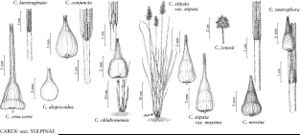Difference between revisions of "Carex jonesii"
Mem. Torrey Bot. Club 1: 16. 1889.
FNA>Volume Importer |
imported>Volume Importer |
||
| (6 intermediate revisions by 2 users not shown) | |||
| Line 6: | Line 6: | ||
|place=1: 16. 1889 | |place=1: 16. 1889 | ||
|year=1889 | |year=1889 | ||
| + | }} | ||
| + | |special_status={{Treatment/ID/Special_status | ||
| + | |code=F | ||
| + | |label=Illustrated | ||
| + | }}{{Treatment/ID/Special_status | ||
| + | |code=E | ||
| + | |label=Endemic | ||
}} | }} | ||
|basionyms= | |basionyms= | ||
| Line 11: | Line 18: | ||
|name=Carex nervina var. jonesii | |name=Carex nervina var. jonesii | ||
|authority=(L. H. Bailey) Kükenthal | |authority=(L. H. Bailey) Kükenthal | ||
| + | |rank=variety | ||
}} | }} | ||
|hierarchy=Cyperaceae;Carex;Carex sect. Vulpinae;Carex jonesii | |hierarchy=Cyperaceae;Carex;Carex sect. Vulpinae;Carex jonesii | ||
| Line 26: | Line 34: | ||
|elevation=900–3200 m | |elevation=900–3200 m | ||
|distribution=Calif.;Colo.;Idaho;Mont.;Nev.;Oreg.;Wash.;Wyo. | |distribution=Calif.;Colo.;Idaho;Mont.;Nev.;Oreg.;Wash.;Wyo. | ||
| − | |discussion=<p>The affinities and sectional placement of Carex jonesii are unclear. Although C. jonesii has often been considered to be part of the C. nervina-C. neurophora complex, it is distinguished from those species by numerous vegetative and reproductive characteristics, including basal leaves with short sheaths with rapidly disintegrating hyaline fronts and perigynia with smooth beaks, oblique, rather than bidentate at the mouth. Carex jonesii is frequently confused with other western montane sedges that have capitate infloresences. It is most often confused with C. illota due to the strong similarity of the perigynia (somewhat shorter and more rounded apically in C. illota). Although C. illota is placed in sect. Ovales based on the gynecandrous spikes, that character can be very difficult to determine in mature plants due to the condensed inflorescence. The ovate, spongy-based perigynia of C. illota suggest a closer relationship with C. jonesii than with typical members of sect. Ovales.</p> | + | |discussion=<p>The affinities and sectional placement of <i>Carex jonesii</i> are unclear. Although <i>C. jonesii</i> has often been considered to be part of the <i>C. nervina</i>-<i>C. neurophora</i> complex, it is distinguished from those species by numerous vegetative and reproductive characteristics, including basal leaves with short sheaths with rapidly disintegrating hyaline fronts and perigynia with smooth beaks, oblique, rather than bidentate at the mouth. <i>Carex jonesii</i> is frequently confused with other western montane sedges that have capitate infloresences. It is most often confused with <i>C. illota</i> due to the strong similarity of the perigynia (somewhat shorter and more rounded apically in <i>C. illota</i>). Although <i>C. illota</i> is placed in sect. Ovales based on the gynecandrous spikes, that character can be very difficult to determine in mature plants due to the condensed inflorescence. The ovate, spongy-based perigynia of <i>C. illota</i> suggest a closer relationship with <i>C. jonesii</i> than with typical members of sect. Ovales.</p> |
|tables= | |tables= | ||
|references= | |references= | ||
| Line 35: | Line 43: | ||
-->{{#Taxon: | -->{{#Taxon: | ||
name=Carex jonesii | name=Carex jonesii | ||
| − | |||
|authority=L. H. Bailey | |authority=L. H. Bailey | ||
|rank=species | |rank=species | ||
| Line 49: | Line 56: | ||
|publication title=Mem. Torrey Bot. Club | |publication title=Mem. Torrey Bot. Club | ||
|publication year=1889 | |publication year=1889 | ||
| − | |special status= | + | |special status=Illustrated;Endemic |
| − | |source xml=https:// | + | |source xml=https://bitbucket.org/aafc-mbb/fna-data-curation/src/2e0870ddd59836b60bcf96646a41e87ea5a5943a/coarse_grained_fna_xml/V23/V23_468.xml |
|genus=Carex | |genus=Carex | ||
|section=Carex sect. Vulpinae | |section=Carex sect. Vulpinae | ||
Latest revision as of 20:41, 5 November 2020
Plants with basal sheaths of previous year persistent as linear fibers. Culms to 60 cm × 2 mm, usually scabrous abaxially. Leaves: proximal sheaths usually all with blades, fronts hyaline, smooth, apex colorless, hyaline, concave, entire; ligules obtuse, 5 mm, free limb to 0.2 mm; blades clustered at base, not epistomic, to 60 cm × 4 mm. Inflorescences very condensed, ovoid to shortly cylindric, with 5–10 individually indistinguishable branches, to 2.5 × 1.5 cm; proximal internodes not visible, not more than 3 mm; proximal bract scalelike, inconspicuous. Scales hyaline, dark brown, subequal to perigynia, acute. Perigynia pale brown, 7–11-veined abaxially, 5–7-veined adaxially, to 3.5 × 1.5 mm, base not distended proximally, rounded or cordate; stipe to 0.1 mm; beak to 1.5 mm, smooth or subserrulate, apex entire, oblique or, sometimes, bidentate with teeth to 0.1 mm. Achenes ovate, to 1.5 × 1 mm; persistent style base cylindric.
Phenology: Fruiting Jul–Aug.
Habitat: Wet subalpine meadows, stream banks
Elevation: 900–3200 m
Distribution

Calif., Colo., Idaho, Mont., Nev., Oreg., Wash., Wyo.
Discussion
The affinities and sectional placement of Carex jonesii are unclear. Although C. jonesii has often been considered to be part of the C. nervina-C. neurophora complex, it is distinguished from those species by numerous vegetative and reproductive characteristics, including basal leaves with short sheaths with rapidly disintegrating hyaline fronts and perigynia with smooth beaks, oblique, rather than bidentate at the mouth. Carex jonesii is frequently confused with other western montane sedges that have capitate infloresences. It is most often confused with C. illota due to the strong similarity of the perigynia (somewhat shorter and more rounded apically in C. illota). Although C. illota is placed in sect. Ovales based on the gynecandrous spikes, that character can be very difficult to determine in mature plants due to the condensed inflorescence. The ovate, spongy-based perigynia of C. illota suggest a closer relationship with C. jonesii than with typical members of sect. Ovales.
Selected References
None.
